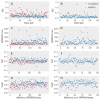Validation of predicted anonymous proteins simply using Fisher's exact test
- PMID: 36700095
- PMCID: PMC9710694
- DOI: 10.1093/bioadv/vbab034
Validation of predicted anonymous proteins simply using Fisher's exact test
Abstract
Motivation: Genomes sequencing has become the primary (and often the sole) experimental method to characterize newly discovered organisms, in particular from the microbial world (bacteria, archaea, viruses). This generates an ever increasing number of predicted proteins the existence of which is unwarranted, in particular among those without homolog in model organisms. As a last resort, the computation of the selection pressure from pairwise alignments of the corresponding 'Open Reading Frames' (ORFs) can be used to validate their existences. However, this approach is error-prone, as not usually associated with a significance test.
Results: We introduce the use of the straightforward Fisher's exact test as a postprocessing of the results provided by the popular CODEML sequence comparison software. The respective rates of nucleotide changes at the nonsynonymous versus synonymous position (as determined by CODEML) are turned into entries into a 2 × 2 contingency table, the probability of which is computed under the Null hypothesis that they should not behave differently if the ORFs do not encode actual proteins. Using the genome sequences of two recently isolated giant viruses, we show that strong negative selection pressures do not always provide a solid argument in favor of the existence of proteins.
© The Author(s) 2021. Published by Oxford University Press.
Figures

References
-
- Abergel C., Claverie J.M. (2020) Giant viruses. Curr. Biol., 30, R1108–R1110. - PubMed
LinkOut - more resources
Full Text Sources
Research Materials

